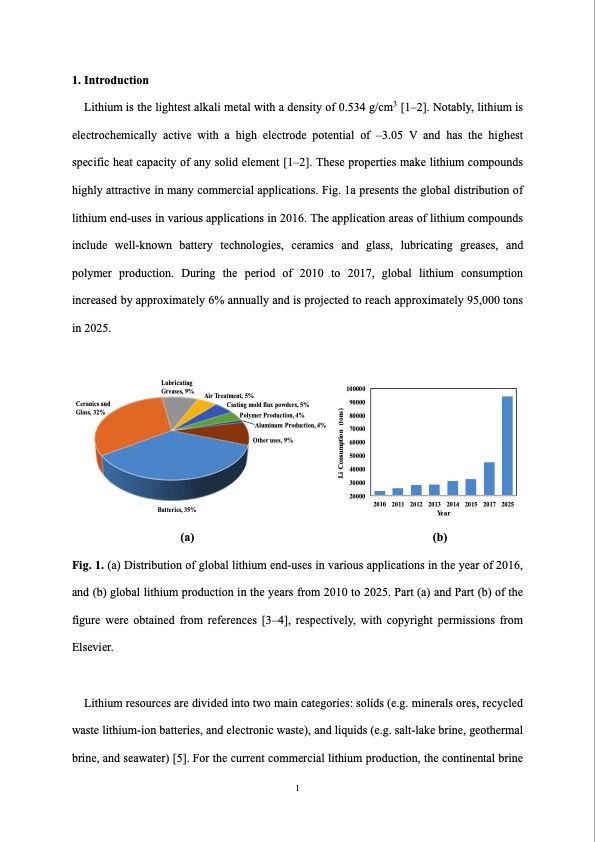
PDF Publication Title:
Text from PDF Page: 005
1. Introduction Lithium is the lightest alkali metal with a density of 0.534 g/cm3 [1–2]. Notably, lithium is electrochemically active with a high electrode potential of –3.05 V and has the highest specific heat capacity of any solid element [1–2]. These properties make lithium compounds highly attractive in many commercial applications. Fig. 1a presents the global distribution of lithium end-uses in various applications in 2016. The application areas of lithium compounds include well-known battery technologies, ceramics and glass, lubricating greases, and polymer production. During the period of 2010 to 2017, global lithium consumption increased by approximately 6% annually and is projected to reach approximately 95,000 tons in 2025. 100000 90000 80000 70000 60000 50000 40000 30000 20000 2010 2011 2012 2013 2014 2015 2017 2025 Year Ceranics and Glass, 32% Lubricating Greases, 9% Batteries, 35% (a) Air Treatment, 5% Casting mold flux powders, 5% Polymer Production, 4% Aluminum Production, 4% Other uses, 9% (b) Fig. 1. (a) Distribution of global lithium end-uses in various applications in the year of 2016, and (b) global lithium production in the years from 2010 to 2025. Part (a) and Part (b) of the figure were obtained from references [3–4], respectively, with copyright permissions from Elsevier. Lithium resources are divided into two main categories: solids (e.g. minerals ores, recycled waste lithium-ion batteries, and electronic waste), and liquids (e.g. salt-lake brine, geothermal brine, and seawater) [5]. For the current commercial lithium production, the continental brine 1 Li Consumption (tons)PDF Image | Membrane based technologies for lithium recovery from water lithium

PDF Search Title:
Membrane based technologies for lithium recovery from water lithiumOriginal File Name Searched:
Content.pdfDIY PDF Search: Google It | Yahoo | Bing
Product and Development Focus for Infinity Turbine
ORC Waste Heat Turbine and ORC System Build Plans: All turbine plans are $10,000 each. This allows you to build a system and then consider licensing for production after you have completed and tested a unit.Redox Flow Battery Technology: With the advent of the new USA tax credits for producing and selling batteries ($35/kW) we are focussing on a simple flow battery using shipping containers as the modular electrolyte storage units with tax credits up to $140,000 per system. Our main focus is on the salt battery. This battery can be used for both thermal and electrical storage applications. We call it the Cogeneration Battery or Cogen Battery. One project is converting salt (brine) based water conditioners to simultaneously produce power. In addition, there are many opportunities to extract Lithium from brine (salt lakes, groundwater, and producer water).Salt water or brine are huge sources for lithium. Most of the worlds lithium is acquired from a brine source. It's even in seawater in a low concentration. Brine is also a byproduct of huge powerplants, which can now use that as an electrolyte and a huge flow battery (which allows storage at the source).We welcome any business and equipment inquiries, as well as licensing our turbines for manufacturing.| CONTACT TEL: 608-238-6001 Email: greg@infinityturbine.com | RSS | AMP |